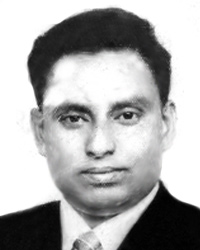Munshiganj Sadar is an upazila of Munshiganj District in the Division of Dhaka, Bangladesh.

In March 1971, the Pakistan Army Eastern Wing Commander Tikka Khan launched Operation Searchlight on the orders of dictator Yahya Khan to crush the Bengali nationalist movement. As part of the operation, the Pakistani forces performed the 1971 Dhaka University massacre.

The 1950 East Pakistan riots took place between Hindus and Muslims in East Pakistan, which resulted in hundreds of thousands of Hindus being killed in pogroms.
Burunga massacre was a massacre of at least 71 members of the Hindu population of Burunga and nearby villages on the Burunga High School grounds, in the district of Sylhet by the Pakistani army on 26 May 1971.
Galimpur massacre was a massacre of the Hindu population of Galimpur in the district of Sylhet by the Pakistani army on 20 May 1971.
Ramna massacre was the massacre of the Hindus who lived in the region around the Ramna Kali temple by the Pakistani army on the night of 27 March 1971. It is estimated that around 250 Hindus were killed in the massacre.
Shankharibazar massacre was a massacre of the Hindus of the Shankharibazar area of Old Dhaka on 26 March 1971 by the Pakistani occupation army. The survivors fled to the villages on the other side of the Buriganga, in the region now known as Keraniganj. Shankharibazar became deserted and dead bodies remained on the streets for quite a long time. The Pakistani establishment renamed the Shankharibazar Road to Tikka Khan Road.
Naria massacre refers to the massacre of Bengali Hindus of Naria village in the district of Sylhet on 5 May 1971 by the Pakistani occupation army.
Adityapur massacre refers to the massacre of Bengali Hindus by the Pakistani occupation army during the Bangladesh Liberation War at Adityapur in Bangladesh. On 14 June 1971, the Pakistani army in collaboration with the Razakars, killed 63 Bengali Hindus in the village of Adityapur in Sylhet district.
Krishnapur massacre took place on 18 September 1971 in Krishnapur and neighbouring villages in the district of Sylhet in Bangladesh. In Krishnapur, the Pakistani occupation army shot 127 Bengali Hindus to death. In the neighbouring villages more than a 100 Hindus were killed.
Ketnar Bil massacre refers to the massacre of unarmed Bengali Hindus in Ketnar Bil region of Barisal District by the Pakistan Occupation Army on 15 May 1971.
Sendia massacre was a massacre of unarmed Bengali Hindus in Sendia village in undivided Faridpur district on 20 May 1971 by the Pakistan Army.< 127 Bengali Hindu men, women and children were killed in the massacre. The killers did not spare even the pregnant women, children or the elderly people. 76 out of the 127 victims were women.

Nizamuddin Ahmed, was a Bangladeshi journalist. On 12 December 1971, he was abducted and killed by an Al-Badr activists team. He was awarded Ekushey Padak posthumously in 1993 by the Government of Bangladesh.
Kaliganj massacre refers to the massacre of unarmed Bengali Hindus fleeing to India in Kaliganj market, in the present day Jaldhaka Upazila of Nilphamari District on 27 April 1971. An estimated 400 Bengali Hindus were killed by the Pakistan Army. It is alleged that this massacre was masterminded by Muslim League leader and central minister Kazi Abdul Kader.
Sutrapur massacre was the massacre of unarmed Bengali Hindu residents of Malakartola Lane of Sutrapur in Dhaka on 27 March 1971. The Pakistan army shot dead fourteen Bengali Hindus and one Muslim in the Loharpool bridge of Sutrapur.
Baria massacre was the massacre of unarmed Bengali Hindus in the village of Baria in present-day Gazipur Sadar Upazila of Bangladesh by the Pakistan army on 14 May 1971. Around 200 Bengali Hindus from Baria and nearby Kamaria were killed in the massacre, while hundreds more were injured.
The Barguna massacre was the mass execution of unarmed residents of Barguna in the Barguna sub-divisional jail by the Pakistan Armed Forces on 29 and 30 May 1971. More than 100 people were killed. Seventy-two of them were identified; the majority were Bengali Hindus, the rest Muslims, mostly supporters of the Bangladesh Awami League and sovereign Bangladesh. In 1992, a memorial was constructed with a marble plaque containing the names of the 72 victims and six other victims killed elsewhere.
Sree Angan massacre refers to the massacre of Bengali Hindu sanyasis of Sree Angan monastery in Faridpur on 21 April 1971. Eights sanyasis were killed by the Pakistan Army in the massacre.
Munshiganj-1 is a constituency represented in the Jatiya Sangsad of Bangladesh since 2019 by Mahi B. Chowdhury of the Bikalpa Dhara Bangladesh.
The Sohagpur massacre was a mass killing of 187 civilians on 25 July 1971 in the Mymensingh District of East Pakistan during the Liberation War. The massacre was perpetrated by the Pakistan Army and Al-Badr, a paramilitary force opposing Bangladeshi independence. Following the massacre, Sohagpur became known as the "village of widows."



